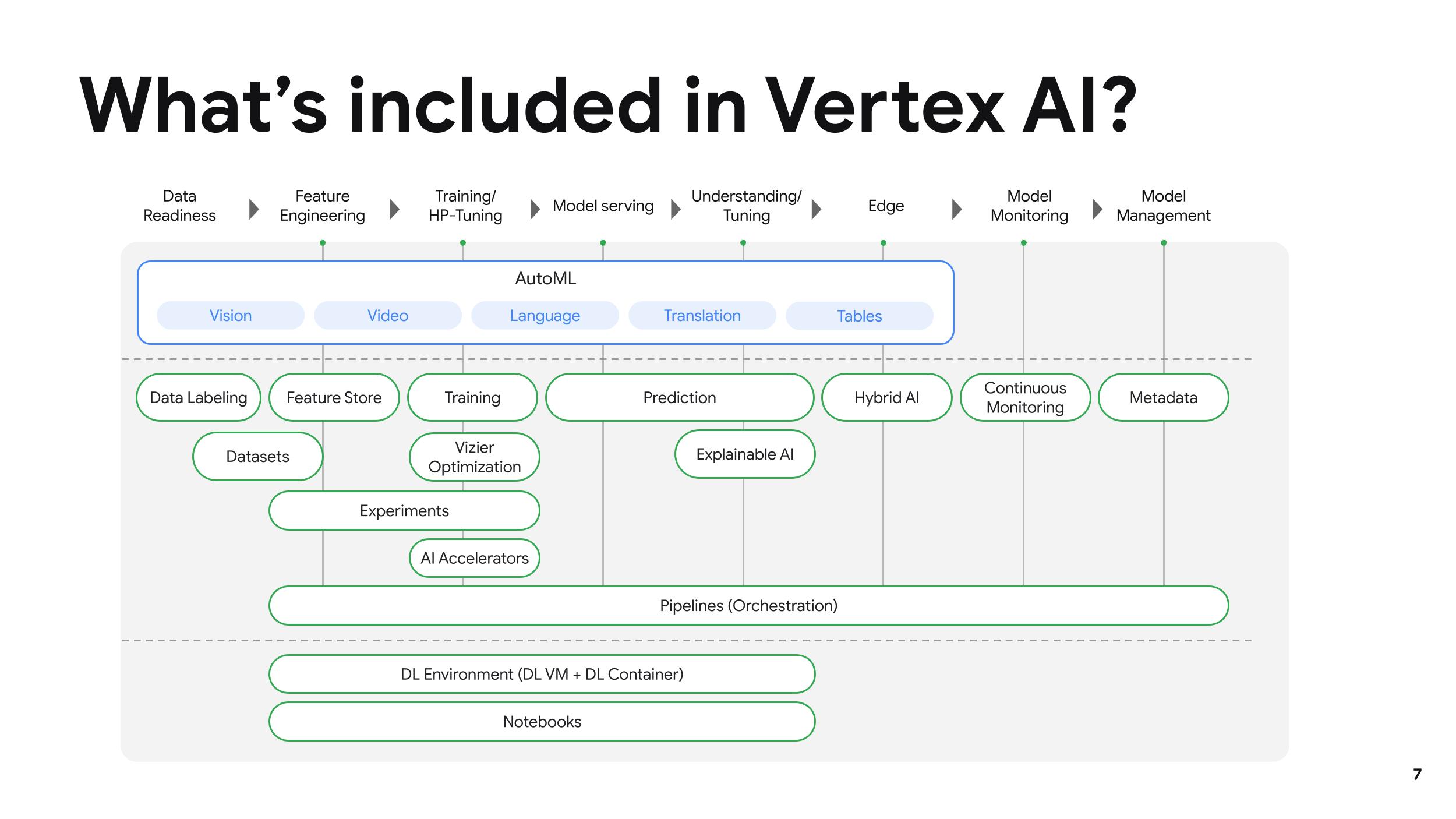GCP Vertex AI Platform
A GCP Vertex AI Platform is an end-to-end cloud-based ML platform that is a Google GCP service.
- Context:
- It can have Vertex AI Components, such as: Vertex Feature Store, Vertex Pipelines, Vertex Monitoring, Vertex Prediction, Vertex Training, ...
- It can be associated with a GCP Vertex AI API.
- It can be associated with GCP Generative AI Service.
- …
- Example(s):
- Counter-Example(s):
- AWS' SageMaker; Azure AI (including Azure ML).
- GCP BigQuery ML Platform.
- GCP Cloud ML Engine [1].
- See: GCP AI Platform.
References
2023
- https://cloud.google.com/vertex-ai/docs/start/introduction-unified-platform
- QUOTE: Vertex AI is a machine learning (ML) platform that lets you train and deploy ML models and AI applications, and customize large language models (LLMs) for use in your AI-powered applications. Vertex AI combines data engineering, data science, and ML engineering workflows, enabling your teams to collaborate using a common toolset and scale your applications using the benefits of Google Cloud.
- …
- This section provides an overview of the machine learning workflow and how you can use Vertex AI to build and deploy your models.
- ML System Data preparation: After extracting and cleaning your dataset, perform exploratory data analysis (EDA) to understand the data schema and characteristics that are expected by the ML model. Apply data transformations and feature engineering to the model, and split the data into training, validation, and test sets. ...
- ML System Model training: Choose a training method to train a model and tune it for performance. ...
- ML System Model evaluation and iteration: Evaluate your trained model, make adjustments to your data based on evaluation metrics, and iterate on your model. ...
- ML System Model monitoring: Monitor the performance of your deployed model. Use incoming prediction data to retrain your model for improved performance. ...
2021
- https://cloud.google.com/vertex-ai
- QUOTE: Build, deploy, and scale ML models faster, with pre-trained and custom tooling within a unified AI platform.
- Build with the groundbreaking ML tools that power Google, developed by Google Research
- Deploy more models, faster, with 80% fewer lines code required for custom modeling
- Use MLOps tools to easily manage your data and models with confidence and repeat at scale
- QUOTE: Build, deploy, and scale ML models faster, with pre-trained and custom tooling within a unified AI platform.
2021
2019
- (Google Cloud, 2019) ⇒ https://cloud.google.com/ml-engine/ Retrieved: 2019-01-06.
- QUOTE: Google Cloud Machine Learning (ML) Engine is a managed service that enables developers and data scientists to build and bring superior machine learning models to production. Cloud ML Engine offers training and prediction services, which can be used together or individually. Cloud ML Engine is a proven service used by enterprises to solve problems ranging from identifying clouds in satellite images, ensuring food safety, and responding four times faster to customer emails. (...)
Machine learning involves training a computer model to find patterns in data. The more high-quality data that you train a well-designed model with, the more intelligent your solution will be. You can build your models with multiple ML frameworks (in beta), including scikit-learn, XGBoost, Keras, and TensorFlow, a state-of-the-art deep learning framework that powers many Google products, from Google Photos to Google Cloud Speech. Cloud ML Engine enables you to automatically design and evaluate model architectures to achieve an intelligent solution faster and without experts. Cloud ML Engine scales to leverage all your data. It can train any model at large scale on a managed cluster.(...)
- QUOTE: Google Cloud Machine Learning (ML) Engine is a managed service that enables developers and data scientists to build and bring superior machine learning models to production. Cloud ML Engine offers training and prediction services, which can be used together or individually. Cloud ML Engine is a proven service used by enterprises to solve problems ranging from identifying clouds in satellite images, ensuring food safety, and responding four times faster to customer emails. (...)
